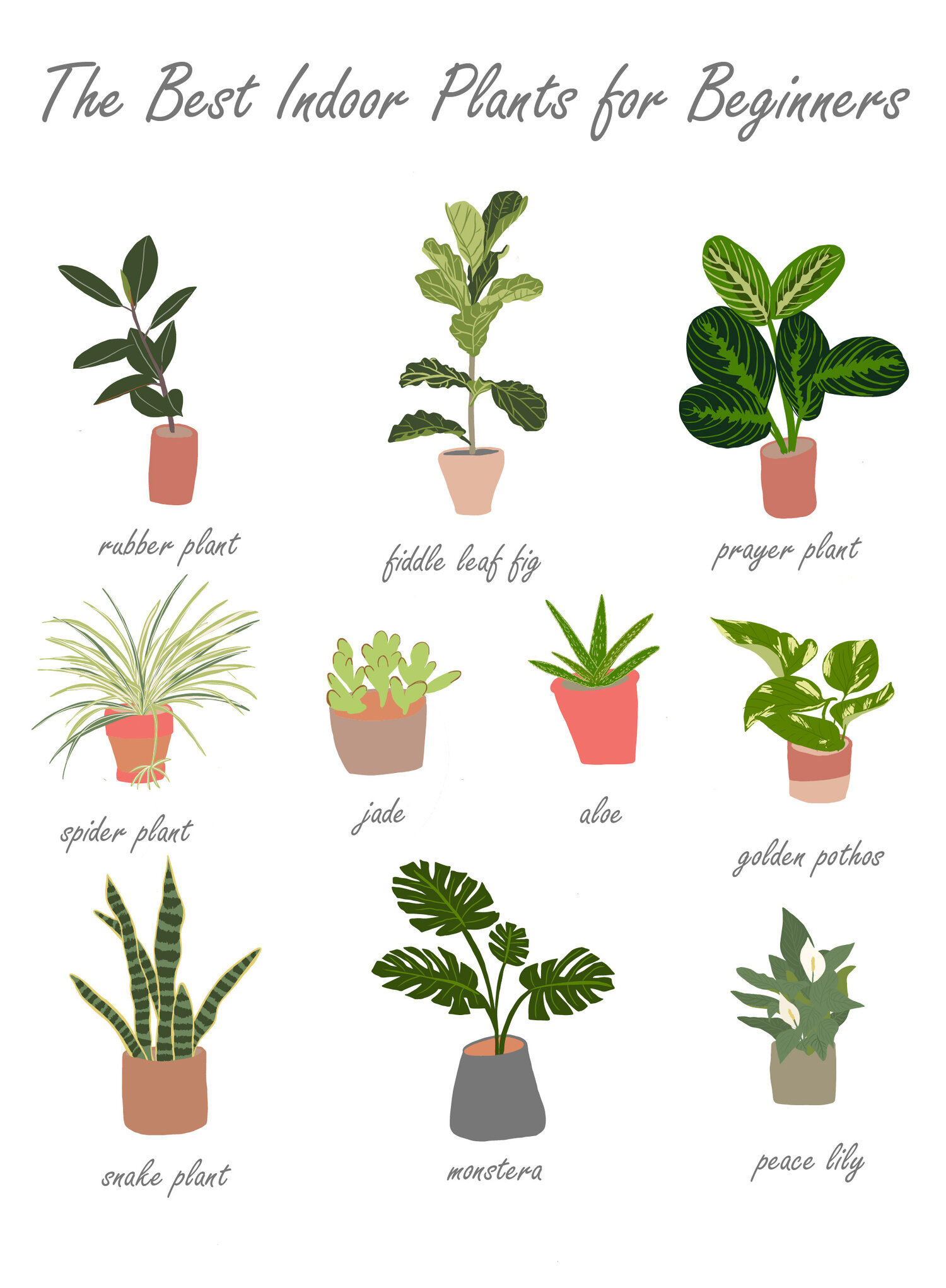Starting a garden can be exciting. But it can also be a bit overwhelming.
Where should a beginner start? For those new to gardening, picking the right plants is crucial. Some plants are easier to care for than others. They are more forgiving if you make mistakes. These plants can thrive with minimal effort, making them perfect for beginners.
By choosing the right plants, you can enjoy a lush garden without too much hassle. Whether you want indoor greenery or a vibrant outdoor garden, there are beginner-friendly options for you. This guide will introduce you to some of the best plants for beginners. With these choices, you can grow your green thumb with confidence and ease. Get ready to dive into the world of gardening with ease!

Credit: environment.co
Spider Plant
The Spider Plant, known for its arching leaves, is perfect for beginners. It adapts well to various environments. Its resilient nature makes it easy to care for. Spider Plants also purify the air, adding health benefits to their beauty. With minimal effort, you can enjoy a lush, green plant in your home.
Care Tips
Spider Plants thrive in bright, indirect sunlight. They can also tolerate low light. Water them once the soil feels dry. Avoid overwatering to prevent root rot. Spider Plants do well in average room temperatures. They prefer humidity but can adapt to dry air. Fertilize them monthly during the growing season for best results.
Common Problems
Brown leaf tips indicate low humidity or fluoride in water. Use distilled water to prevent this. Yellow leaves usually mean overwatering. Check the soil before watering. Spider Plants are prone to spider mites. Wipe leaves with a damp cloth to keep them clean. If pests persist, use insecticidal soap.

Credit: aledomainstreet.com
Snake Plant
The Snake Plant, also known as Sansevieria, is a popular choice for beginners. It is known for its hardiness and ability to thrive in various conditions. This plant is also called the Mother-in-Law’s Tongue due to its long, sharp leaves.
Light And Water Requirements
Snake Plants are very adaptable. They can thrive in a range of light conditions, from low light to bright, indirect sunlight. This makes them perfect for any room in your home.
| Light Requirement | Water Requirement |
|---|---|
| Low to Bright Indirect Light | Water Every 2-3 Weeks |
Watering is simple. Allow the soil to dry completely between waterings. Overwatering can lead to root rot. So, it’s better to underwater than overwater.
Propagation Methods
Propagating Snake Plants is easy and rewarding. There are two main methods: division and leaf cuttings.
- Division: Separate the plant into smaller sections, each with roots attached. Plant these sections in new pots.
- Leaf Cuttings: Cut a healthy leaf into sections. Allow the cut ends to dry for a day or two. Plant the cuttings in soil, cut side down.
Both methods are simple and effective. They can increase your plant collection quickly.
Pothos
Pothos is a popular houseplant known for its heart-shaped leaves and trailing vines. It’s perfect for beginners due to its low maintenance and adaptability. Whether you have a green thumb or not, Pothos can thrive with minimal care.
Ideal Growing Conditions
Pothos thrives in a variety of lighting conditions. It can grow well in low to bright, indirect light. Avoid direct sunlight, as it can scorch the leaves.
| Condition | Ideal Range |
|---|---|
| Light | Low to bright, indirect light |
| Water | Moderate; water when soil is dry |
| Temperature | 60-85°F (15-29°C) |
| Humidity | 50-70% |
Pothos prefers well-draining soil. A mix of potting soil, perlite, and peat moss works well. Ensure the pot has drainage holes to prevent waterlogging.
Pruning And Maintenance
Pruning helps keep your Pothos healthy and attractive. Trim the vines back to maintain the desired length. Use clean scissors or pruning shears.
- Identify the stems you want to cut.
- Make a clean cut just above a leaf node.
- Remove any yellow or damaged leaves.
Pothos is susceptible to pests like spider mites and mealybugs. Regularly inspect the leaves and treat any infestations promptly. Wipe the leaves with a damp cloth to remove dust and keep the plant looking vibrant.
Fertilize your Pothos every 2-3 months during the growing season. Use a balanced liquid fertilizer at half strength. Over-fertilization can harm the plant, so less is more.
Repotting is necessary every 1-2 years. Choose a pot that is one size larger than the current one. This gives the roots more space to grow.
With these simple steps, your Pothos will remain a lush, green addition to your home.
Succulents
Succulents are perfect for beginner gardeners. These plants are hardy and low-maintenance. They store water in their leaves, which helps them thrive in dry conditions. Succulents come in various shapes and sizes, making them a versatile choice for any home.
Best Types For Beginners
Some succulents are easier to care for than others. The Jade Plant is a popular choice. It has thick, glossy leaves and can live for many years. The Aloe Vera plant is also easy to grow. It needs little water and has healing properties. The Zebra Plant is another great option. Its striped leaves add a unique touch to any room.
Watering Guidelines
Overwatering is the most common mistake with succulents. They need less water than most plants. Water them every two weeks in summer. In winter, water once a month. Make sure the soil is dry before watering again. Use pots with drainage holes to prevent root rot. A little care goes a long way with succulents.
Zz Plant
The ZZ Plant is perfect for beginners. It thrives in low light and needs little water. Ideal for easy-care gardening.
The ZZ Plant, also known as Zamioculcas zamiifolia, is perfect for beginners. This plant thrives on neglect, making it ideal for busy people. Its shiny, dark green leaves add beauty to any room. The ZZ Plant is low maintenance and can survive in low light. This makes it a popular choice for homes and offices.
Growth Habits
The ZZ Plant grows slowly. It reaches around 3 feet tall indoors. Its thick, waxy leaves store water. This helps the plant survive drought. The leaves grow from thick, underground stems. These stems also store nutrients. This plant can live in low light but grows faster in bright, indirect light.
Common Issues
Overwatering is a common issue. It leads to root rot. Water the ZZ Plant only when the soil is dry. Yellow leaves can indicate too much water. Place the plant in a well-draining pot. Low light causes slow growth. Move the plant to a brighter spot if needed. Pests are rare but can include spider mites. Wipe the leaves with a damp cloth if pests appear.

Credit: www.pinterest.com
Peace Lily
The Peace Lily is perfect for beginners. It’s easy to care for and has beautiful white blooms. This plant purifies the air, making your home healthier. It thrives in low light, which is great for indoor spaces.
Bloom Care
Peace Lilies produce lovely white flowers. To encourage blooms, place the plant in a bright spot. Avoid direct sunlight as it can scorch the leaves. Keep the soil moist but not soggy. Water when the top inch feels dry.
Fertilizing Needs
Peace Lilies need minimal fertilizing. Use a balanced houseplant fertilizer once a month during spring and summer. Dilute the fertilizer to half strength to avoid overfeeding. Fertilizing helps maintain lush, green leaves.
Aloe Vera
Aloe Vera is a fantastic choice for beginner gardeners. This succulent plant is easy to care for and offers many benefits. Aloe Vera’s thick, green leaves can thrive indoors or outdoors. It requires minimal attention and can withstand neglect. Let’s explore some of the key aspects of Aloe Vera care.
Health Benefits
Aloe Vera is known for its healing properties. The gel inside its leaves soothes burns and cuts. Many people use it to treat sunburns. It also helps moisturize the skin. Aloe Vera gel can reduce inflammation and irritation. Some people drink Aloe Vera juice for digestive health. Always consult a doctor before trying new remedies.
Repotting Tips
Repotting Aloe Vera is simple. Choose a pot with drainage holes. Use a well-draining soil mix. Gently remove the plant from its old pot. Shake off excess soil from the roots. Place the plant in the new pot. Fill the pot with soil, covering the roots. Water the plant lightly after repotting. Allow the soil to dry out between waterings. Repot Aloe Vera every two to three years. This helps the plant grow healthy and strong.
Frequently Asked Questions
What Are The Easiest Plants For Beginners?
Spider plants, pothos, and succulents are great for beginners. They require minimal care and are very forgiving.
How Often Should I Water My Beginner Plants?
Most beginner plants need watering once a week. Always check the soil moisture first to avoid overwatering.
Do Beginner Plants Need Direct Sunlight?
Not all beginner plants need direct sunlight. Many, like snake plants and pothos, thrive in low to medium light.
Can Indoor Plants Improve Air Quality?
Yes, indoor plants can improve air quality. They absorb toxins and release oxygen, creating a healthier environment.
Conclusion
Starting with easy plants builds confidence in gardening. These plants require minimal care. They thrive in various conditions. You’ll enjoy their beauty and benefits quickly. Remember, patience is key in gardening. With time, you’ll learn more. Happy gardening!


